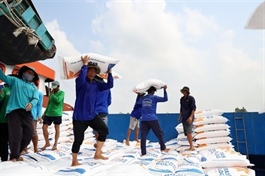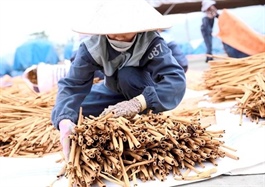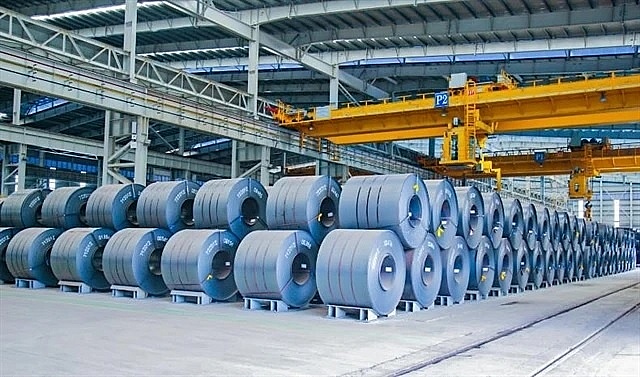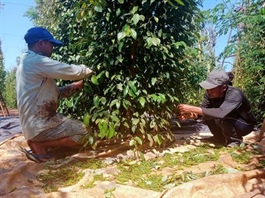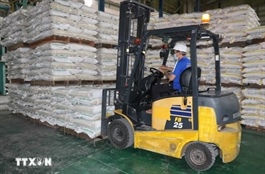Tân Lạc red pomelo: from local delicacy to global export aspirations
Tân Lạc red pomelo: from local delicacy to global export aspirations
Amid the verdant landscapes of Hòa Bình Province, the Tân Lạc red pomelo has emerged as a symbol of agricultural innovation and economic promise.
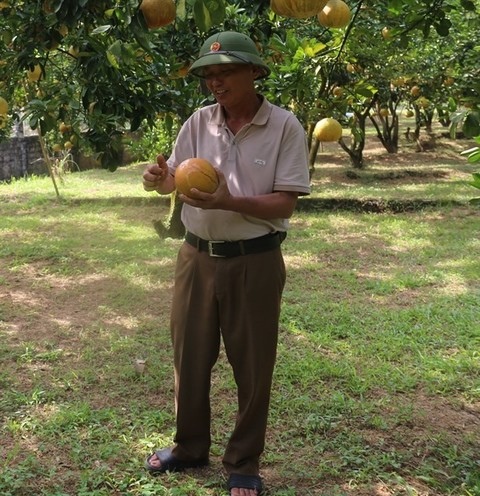
Dương Văn Tính, a 72-year-old veteran and director of the Tân Hương Red Pomelo Cooperative, shows off a Tân Lạc red pomelo. — VNS Photo Tiến Đạt |
Pomelo is one of Việt Nam's key crops, planted across 105,400 hectares, with orchards producing nearly 905,000 tonnes annually. In addition to local sales, many regions are focusing on exporting this specialty fruit, and to date it is being exported to about 19 markets.
According to the Ministry of Agriculture and Rural Development, each region grows its own unique types of pomelos, including green-skinned, Năm Roi, Diễn and Đoan Hùng varieties.
Notably, the Tân Lạc red pomelo, known for its sweet, mild flavour and striking reddish-pink flesh, is boosting the livelihoods of farmers in Hòa Bình Province, and helping Việt Nam’s agricultural products gain more recognition across global markets.
With over 1,200 hectares dedicated to red pomelo cultivation, Tân Lạc District has become a significant producer, yielding an estimated 20,000 tonnes annually.
“We’ve identified red pomelo as a key crop in our district’s agricultural development strategy,” Phùng Văn Thái, an officer from the Department of Agriculture and Rural Development in Tân Lạc District, told Việt Nam News.
“To maximise its economic potential, we’re actively promoting trade, attracting investment and providing material support to farmers,” he said.
A mature pomelo tree, at five years old, can produce between 260 and 320 fruits each year, so the impact on local farmers is substantial.
“With proper care, each hectare can generate an average income of about VNĐ150 million (US$5,900), with some households earning several hundred million annually,” Thái noted. Regions such as Thanh Hối, Đông Lai and Tử Nê have reported even higher incomes, reaching up to VNĐ415 million per hectare.
In 2022, Tân Lạc red pomelo took a significant step onto the international stage with an initial export of six tonnes to the United Kingdom. “Exporting to the UK not only opens up a new market but also enhances the value of our pomelos, showing how our product has met the stringent quality and food safety standards of the European market,” Thái said.
Through a contract with RYB Joint Stock Company in Hà Nội, Tân Lạc supplied 9,000 red pomelos, a total of nine tonnes, for export. Each fruit weighs between 0.9 and 1.2 kilogrammes and adheres to strict standards regarding pesticide residue, sweetness and colour.
Buoyed by this success, Tân Lạc District aims to enter other demanding markets such as the United States, the European Union and New Zealand.
“This year, we plan to export between 1,000 and 1,200 tonnes of red pomelo to these markets. It’s a significant opportunity to boost economic value for local farmers and strengthen the Tân Lạc red pomelo brand internationally.” Thái added.
Challenges on the horizon

Tourists visit the pomelo orchard of Dương Văn Tính. — VNS Photo Tiến Đạt |
Despite these achievements, exporting Tân Lạc red pomelo is not without challenges. “International markets impose rigorous requirements. Products must meet high-quality standards and undergo strict inspection processes, such as irradiation,” Thái explained.
A major hurdle is the lack of any irradiation facility in northern Việt Nam.
“We’re forced to transport pomelos to the south for irradiation before export, which increases time and costs. These expenses can reduce farmers' profits and affect the product’s competitiveness globally.” Thái said.
Additionally, uncontrolled cultivation has led to declining domestic prices.
Dương Văn Tính, a 72-year-old veteran and director of the Tân Hương Red Pomelo Cooperative, was among the pioneers of red pomelo cultivation in Tân Lạc.
“I began planting red pomelo in 2004. Initially, prices were high, with each fruit selling for VNĐ30,000 to VNĐ35,000. However, prices have dropped significantly due to uncontrolled cultivation,” Tính told Việt Nam News.
This decline has prompted some farmers to neglect their orchards or switch to other crops like acacia for paper production. “This not only affects their income but also the reputation of Tân Lạc red pomelo,” Tính added.
Legal issues, market fluctuations and middlemen also hinder pomelo cultivation growth. Farmers sometimes break contracts for higher prices, while financial constraints prevent cooperatives from investing in necessary agricultural infrastructure.
“Some cooperative members aren’t proactive in intensive farming and care, leading to inconsistent product quality,” Tính said.
A strategic vision

Dương Văn Tính picks pomelos with tourists in the orchard. — VNS Photo Tiến Đạt |
To overcome challenges and promote Tân Lạc red pomelo globally, the district has developed a clear strategy.
The first step is to improve farming practices by adopting advanced techniques like efficient irrigation, organic fertilisers and eco-friendly pest control. Grafting low-yield areas is also a focus to increase both quantity and quality.
The district also supports producers by encouraging larger-scale farming and the formation of cooperatives to improve coordination in farming, harvesting and marketing. Vocational training and business education help farmers gain skills for better production and trading, making them more competitive.
Attracting investment is a key focus for Tân Lạc District, which is creating favourable conditions for investors and businesses to partner in production and product sales. Establishing processing facilities near production sites is crucial for long-term growth and a stronger supply chain for red pomelo.
The district is also prioritising technological innovation. By promoting research and the use of high-tech methods in production, processing and preservation, it aims to modernise the industry.
The district is focused on improving certification and standards by supporting the establishment of planting area and packing facility codes. It also helps adopt good agricultural practices like VietGAP, GlobalG.A.P and organic standards to access premium markets and ensure product quality.
Additionally, the district is working on product standardisation to boost the competitiveness and brand identity of Tân Lạc red pomelo under the OCOP (One Commune One Product) standard, contributing to the region’s sustainable economic development as a whole.
“By focusing on these areas, we aim to create specialised cultivation zones that meet international standards, providing technical training for farmers, along with intensifying trade promotion and marketing, are also crucial steps,” Thái said.
With the combined efforts of local authorities, agricultural experts and dedicated farmers, Tân Lạc red pomelo is poised for greater success.
“If we work together and adhere to technical procedures, our pomelos will not only bring economic benefits but also enhance the status of Vietnamese agricultural products globally,” Tính said with optimism.






